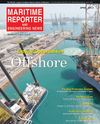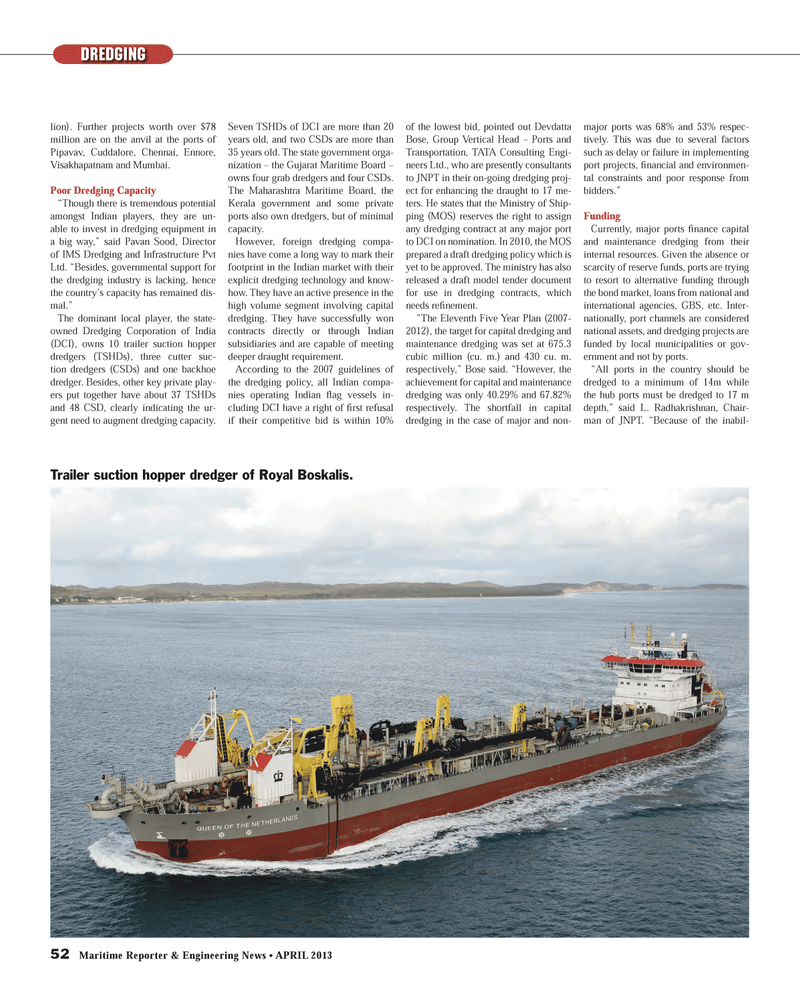
Page 52: of Maritime Reporter Magazine (April 2013)
Offshore Energy Edition
Read this page in Pdf, Flash or Html5 edition of April 2013 Maritime Reporter Magazine
52 Maritime Reporter & Engineering News ? APRIL 2013 lion). Further projects worth over $78 million are on the anvil at the ports of Pipavav, Cuddalore, Chennai, Ennore, Visakhapatnam and Mumbai. Poor Dredging Capacity ?Though there is tremendous potential amongst Indian players, they are un-able to invest in dredging equipment in a big way,? said Pavan Sood, Director of IMS Dredging and Infrastructure Pvt Ltd. ?Besides, governmental support for the dredging industry is lacking, hence the country?s capacity has remained dis- mal.?The dominant local player, the state- owned Dredging Corporation of India (DCI), owns 10 trailer suction hopper dredgers (TSHDs), three cutter suc-tion dredgers (CSDs) and one backhoe dredger. Besides, other key private play- ers put together have about 37 TSHDs and 48 CSD, clearly indicating the ur- gent need to augment dredging capacity. Seven TSHDs of DCI are more than 20 years old, and two CSDs are more than 35 years old. The state government orga- nization ? the Gujarat Maritime Board ? owns four grab dredgers and four CSDs. The Maharashtra Maritime Board, the Kerala government and some private ports also own dredgers, but of minimal capacity. However, foreign dredging compa- nies have come a long way to mark their footprint in the Indian market with their explicit dredging technology and know-how. They have an active presence in the high volume segment involving capital dredging. They have successfully won contracts directly or through Indian subsidiaries and are capable of meeting deeper draught requirement.According to the 2007 guidelines of the dredging policy, all Indian compa- nies operating Indian ß ag vessels in- cluding DCI have a right of Þ rst refusal if their competitive bid is within 10% of the lowest bid, pointed out Devdatta Bose, Group Vertical Head ? Ports and Transportation, TATA Consulting Engi- neers Ltd., who are presently consultants to JNPT in their on-going dredging proj- ect for enhancing the draught to 17 me-ters. He states that the Ministry of Ship-ping (MOS) reserves the right to assign any dredging contract at any major port to DCI on nomination. In 2010, the MOS prepared a draft dredging policy which is yet to be approved. The ministry has also released a draft model tender document for use in dredging contracts, which needs reÞ nement. ?The Eleventh Five Year Plan (2007- 2012), the target for capital dredging and maintenance dredging was set at 675.3 cubic million (cu. m.) and 430 cu. m. respectively,? Bose said. ?However, the achievement for capital and maintenance dredging was only 40.29% and 67.82% respectively. The shortfall in capital dredging in the case of major and non-major ports was 68% and 53% respec-tively. This was due to several factors such as delay or failure in implementing port projects, Þ nancial and environmen- tal constraints and poor response from bidders.?Funding Currently, major ports Þ nance capital and maintenance dredging from their internal resources. Given the absence or scarcity of reserve funds, ports are trying to resort to alternative funding through the bond market, loans from national and international agencies, GBS, etc. Inter- nationally, port channels are considered national assets, and dredging projects are funded by local municipalities or gov-ernment and not by ports.?All ports in the country should be dredged to a minimum of 14m while the hub ports must be dredged to 17 m depth,? said L. Radhakrishnan, Chair- man of JNPT. ?Because of the inabil- DREDGINGTrailer suction hopper dredger of Royal Boskalis. MR #4 (50-57).indd 52MR #4 (50-57).indd 524/2/2013 4:36:43 PM4/2/2013 4:36:43 PM

 51
51

 53
53
